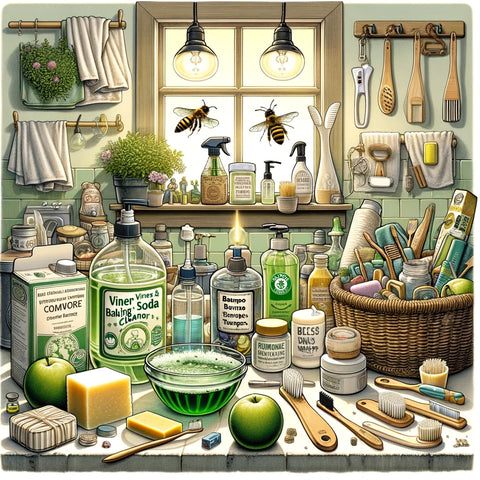Transitioning to Eco-Friendly Living
Green Living Unveiled: The Joyful Shift to Eco-Friendly Household Products
Green Living
The growing demand for environmentally conscious consumer goods is indicative of a sea change in perspective and behavior, not merely a passing trend. We are committed to progressively incorporating eco-friendly products into our household. I went this route because I believe that our collective actions, no matter how seemingly insignificant, have an effect on the planet. The importance of leading an eco-friendly lifestyle is demonstrated via this narrative of invention, discovery, and, occasionally, humorous trial and error.
Determined to replace my collection of dangerous chemicals with safer alternatives, I started my journey in the cleaning section of a nearby supermarket. I learned a lot from the change. I had the idea that vinegar, baking soda, and lemon, which are all natural ingredients, may be just as effective as chemical-laden alternatives—but with less of an effect on the environment. It was as if I had rediscovered the primordial language of cleanliness and was now receiving its wisdom from the soil.
On the path to become an eco-friendly residence, we experienced our share of humorous mistakes. As an example, one may think of the well-known laundry soap experiment. Instead of the spring meadow scent the article had described, the homemade mixture I concocted reeked more of an odd salad. The bamboo toothbrush fiasco in which the bristles fell out in the middle of the brush taught me that not all eco-friendly items are created equal.
In spite of everything, I've been researching eco-friendly items that are recyclable, biodegradable, and reusable since I'm committed to making a difference. Every product seemed to be an attempt to make things greener; beeswax wraps purportedly decreased plastic waste with each wash, while shampoo bars promised to make the home a greener place. Our journey also taught us the value of supporting local businesses and artists whose wares are gentler on the environment. Through this approach, we may cultivate a group of buyers and sellers who are cognizant of the impact they can exert.
The most rewarding part of switching to eco-friendly household items has been seeing the positive impact on others in my immediate vicinity. If you convince your loved ones of the merits of biodegradable dish sponges or the simplicity of switching to LED lights, they are more inclined to follow your lead. An important lesson to be learned from this is that even small acts can have far-reaching consequences.
The trend toward more environmentally friendly consumer products is dynamic, changing over time in reaction to new information. This rethought way of life that is in sync with the natural cycles is a great illustration of how sustainable living doesn't have to compromise on efficiency or quality. From this angle, it's not simply a household item—every environmentally friendly object we purchase is a representation of our dedication to preserving our world.
Let us attempt to picture this transition to eco-friendly home goods for the sake of comprehension. Envision a setting that highlights the cutting-edge tools and techniques that enable sustainable living to be not just feasible, but also enjoyable and satisfying. It exemplifies the way sustainability is woven into the fabric of everyday life.We modify our habits and the way we communicate when we make an effort to live more sustainably at home. Slowly but surely, we are outfitting our homes with eco-friendly furniture. I set out on my journey when I realized that our seemingly little deeds have an impact on the globe. Embracing a green lifestyle may lead to great innovations, discoveries, and even humorous catastrophes.
Natural, non-toxic cleaning supplies are now available in my shop. I was startled awake by this shift. I found that non-toxic alternatives to chemicals, such as vinegar, baking soda, and lemon, may accomplish almost the same outcomes. It was as if I had deciphered the planet's secret language of innocence as I listened.
Funny accidents are essential for a greenhouse. In contrast to the spring meadow aroma, the handcrafted variety in the large-scale laundry soap trial reeked of an odd salad. When the bristles of my bamboo toothbrush fell out mid-brushing, I discovered the hard way that not all environmentally friendly products are the same.
In spite of these obstacles, I persisted in researching sustainable materials that could be recycled, biodegraded, and reused. Shampoo bars claimed to reduce plastic usage with each use, and beeswax packaging supplanted cling film. On top of learning about sustainable businesses and craftspeople, the trip highlighted the need of building a community of conscientious consumers and creatives.
Helping other people is a great source of delight, which is a powerful motivator to buy eco-friendly home items. After talking it over with loved ones, eco-friendly products like LED lights and biodegradable dish sponges might change the game. Small changes made at home may make a big difference.
Green home things are a byproduct of every new innovation and discovery. When you prioritize environmental protection with your own well-being, you are living a sustainable lifestyle. Green home goods, kitchen appliances, and toiletries are a few ways we can do our part to save the planet.
Envision yourself transitioning to environmentally conscious household items. Imagine a poster advertising easy-to-implement, entertaining, and financially rewarding eco-friendly products and practices.





Leave a comment